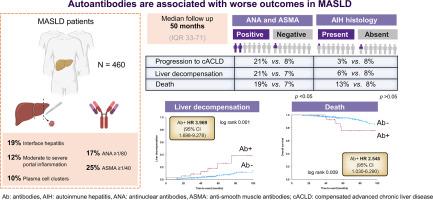Autoantibodies are associated with worse outcomes in MASLD
IF 7.5
1区 医学
Q1 GASTROENTEROLOGY & HEPATOLOGY
引用次数: 0
Abstract
Background & Aims
Metabolic dysfunction-associated steatotic liver disease (MASLD) is a leading cause of chronic liver disease worldwide. Autoantibodies (Ab), such as antinuclear antibodies (ANA) and anti-smooth muscle antibodies (ASMA), are frequently detected in MASLD, but their role in disease progression remains controversial. This study aimed to evaluate the prevalence of positive Ab and the histological features of autoimmune hepatitis (AIH) in MASLD and their association with liver-related outcomes.
Methods
We conducted a multicenter, retrospective, longitudinal study of patients with biopsy-proven MASLD from the HEPAmet Registry. Data on ANA (≥1/80), ASMA (≥1/40), and AIH histological features (portal inflammation, interface hepatitis, and plasma cell infiltration) were analyzed for their association with compensated advanced chronic liver disease (cACLD), liver decompensation, and death.
Results
Of the 460 patients (49% women, median age 58 years, median BMI 33 kg/m2, and 45% with advanced fibrosis), 17% and 25% tested positive for ANA and ASMA, respectively. Histological features of AIH included interface hepatitis (19%), moderate/severe portal inflammation (12%), and plasma cell clusters (10%). Possible AIH based on histological criteria was present in 8% of patients. The presence of positive Ab was independently associated with cACLD development (odds ratio 2.890, p <0.030), liver decompensation (hazard ratio 3.969, p = 0.001), and death (hazard ratio 2.546, p = 0.036). In contrast, the presence of isolated histologic autoimmune features was not correlated with serological markers and did not affect the prognosis of MASLD.
Conclusions
ANA and ASMA are commonly found in patients with MASLD and are associated with poorer liver-related outcomes and reduced survival, whereas isolated histological autoimmune features provide no additional prognostic value.
Impact and implications
Metabolic dysfunction-associated steatotic liver disease (MASLD) can coexist with other liver diseases, including autoimmune hepatitis. The role of autoantibodies and histological autoimmune features in MASLD progression remains controversial. Understanding the relationship between autoimmune characteristics and disease progression in MASLD may help physicians identify high-risk populations, enhance risk stratification, and personalize disease treatment.

自身抗体与MASLD的不良预后相关
背景和目的代谢功能障碍相关脂肪变性肝病(MASLD)是世界范围内慢性肝病的主要原因。自身抗体(Ab),如抗核抗体(ANA)和抗平滑肌抗体(ASMA),在MASLD中经常被检测到,但它们在疾病进展中的作用仍然存在争议。本研究旨在评估MASLD中Ab阳性的患病率和自身免疫性肝炎(AIH)的组织学特征及其与肝脏相关预后的关系。方法:我们对HEPAmet Registry中活检证实的MASLD患者进行了一项多中心、回顾性、纵向研究。分析ANA(≥1/80)、ASMA(≥1/40)和AIH组织学特征(门静脉炎症、界面肝炎和浆细胞浸润)与代偿性晚期慢性肝病(cACLD)、肝脏失代偿和死亡的相关性。结果在460例患者中(49%为女性,中位年龄58岁,中位BMI为33 kg/m2, 45%为晚期纤维化),分别有17%和25%的ANA和ASMA检测呈阳性。AIH的组织学特征包括界面肝炎(19%)、中重度门脉炎(12%)和浆细胞聚集(10%)。根据组织学标准,8%的患者可能存在AIH。Ab阳性的存在与cACLD的发展(优势比2.890,p <0.030)、肝脏失代偿(危险比3.969,p = 0.001)和死亡(危险比2.546,p = 0.036)独立相关。相反,孤立的组织学自身免疫特征的存在与血清学标志物无关,也不影响MASLD的预后。结论:sana和ASMA在MASLD患者中普遍存在,并与肝脏相关预后较差和生存率降低相关,而孤立的组织学自身免疫特征没有提供额外的预后价值。影响和意义代谢功能障碍相关脂肪变性肝病(MASLD)可与其他肝脏疾病共存,包括自身免疫性肝炎。自身抗体和组织学自身免疫特征在MASLD进展中的作用仍然存在争议。了解自身免疫特征与MASLD疾病进展之间的关系可以帮助医生识别高危人群,加强风险分层,并个性化疾病治疗。
本文章由计算机程序翻译,如有差异,请以英文原文为准。
求助全文
约1分钟内获得全文
求助全文
来源期刊

JHEP Reports
GASTROENTEROLOGY & HEPATOLOGY-
CiteScore
12.40
自引率
2.40%
发文量
161
审稿时长
36 days
期刊介绍:
JHEP Reports is an open access journal that is affiliated with the European Association for the Study of the Liver (EASL). It serves as a companion journal to the highly respected Journal of Hepatology.
The primary objective of JHEP Reports is to publish original papers and reviews that contribute to the advancement of knowledge in the field of liver diseases. The journal covers a wide range of topics, including basic, translational, and clinical research. It also focuses on global issues in hepatology, with particular emphasis on areas such as clinical trials, novel diagnostics, precision medicine and therapeutics, cancer research, cellular and molecular studies, artificial intelligence, microbiome research, epidemiology, and cutting-edge technologies.
In summary, JHEP Reports is dedicated to promoting scientific discoveries and innovations in liver diseases through the publication of high-quality research papers and reviews covering various aspects of hepatology.
 求助内容:
求助内容: 应助结果提醒方式:
应助结果提醒方式:


